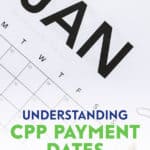Understanding CPP Payment Dates for 2024

Canadians who have paid into the Canadian Pension Plan (CPP) during their working years benefit by receiving payments on a monthly basis when they retire. Unlike other social insurance benefits, such as Old Age Security (OAS), CPP requires a contribution to the plan while you are an employee. The monthly benefit you receive depends on a number of factors, including your contribution amount, and the number of years you paid into the benefit.
In this article, I’ll cover everything you need to know about the CPP, including how the payments work. I’ll also touch on the differences between CPP and OAS. Ready? Let’s dive in.
CPP Minimum Requirements
There are 2 minimum requirements Canadians must meet in order to be eligible to receive CPP payments. That is, they must be at least 60 years old, and they have to have made at least one contribution to the CPP during their working years. Of course, one contribution won’t result in much in the way of a retirement benefit, but it is a qualifier. If you did not work in Canada, but your former spouse or common-law partner did, you may qualify through credits you receive from them.
I should point out, that CPP is not automatically paid out. You must apply in advance. It’s usually recommended that you begin the application process at least 6 months prior to the date you wish to begin receiving the benefit.
How Much Will My CPP Payment Be?
While I would love to give you a straightforward answer, your eventual CPP benefit is based on three factors:
- Your average earnings throughout your working life (age 18-65)
- The amount of contributions you make to the CPP
- The age at which you begin receiving CPP Payments
When Can I Begin Collecting CPP Payments?
You can receive an unreduced CPP payment as soon as you reach age 65. You can also start as early as age 60, or as late as age 70. If you opt to receive your CPP benefit early, the monthly amount will be permanently reduced by .60% for every month before you turn 65. This equates to a 7.2% annually, up to a maximum clawback of 36% if you were to begin collecting right at age 60. On the flip side, if you wait until after you turn 65, your benefit will permanently increase by .70% for every month that you delay. Waiting until age 70 would result in a 42% increase in your CPP benefit.
There are varying opinions about when you should start collecting CPP, but it really comes down to your individual situation, more specifically, what other income sources you will have to draw on at retirement. Many people think that it’s best to begin collecting as soon as you turn 60. Even though it means receiving a smaller benefit, there are no guarantees in life, so why not take the money as soon as it’s available. Others say that if you have enough money to live on without CPP, why not hold off and let the monthly payment amount build up. This could apply if you and/or your spouse are still working, or you have other pension/income to draw on.
What Is the Maximum CPP for 2022?
Below is the maximum monthly and annual CPP benefit amount for 2022, at ages 65 and 70, respectively:
| Age | Monthly Amount (Max) | Annual Amount (Max) |
|---|---|---|
| 65 | $1,253.59 | $15,043.08 |
| 70 | $1,780.10 | $21,361.20 |
It’s important to note that the majority of Canadian workers will not receive the maximum CPP amount. In fact, the average monthly CPP payment for new beneficiaries at age 65 is closer to $780, and for those at age 70, $997. This is due to the fact that not everyone contributes the maximum amount each year they are working, nor are they all working 39 out of the 47 years between 18-65, which is a requirement to receive the maximum CPP benefit.
How to Apply for CPP
It’s recommended that you begin the process to apply for CPP six months prior to the date you wish to begin receiving payments. On their website, the Government of Canada notes that it can take up to 120 days (4 months) to process applications that they receive by mail, or are dropped off at Service Canada locations. You could be cutting it close, however, if your application has errors and needs to be resubmitted, or corrected. If you apply online, the processing is much quicker, between 7 and 14 days.
What Is the CPP Enhancement?
In 2019, changes were made to the CPP program to ensure its viability well into the future. With contribution rates rising, the goal is for CPP to eventually replace 33.33% of a person’s pre-retirement income. Currently, the plan replaces 25%. To accomplish this, both employees and employers will see their contributions rise. In 2022, for example, the combined contribution is 11.4% of earnings, up to the Yearly Maximum Pensionable Amount, or YMPE (more on that in a moment). By 2023, the total contribution will rise to 11.90%, before levelling off.
Yearly Maximum Pensionable Earnings (YMPE)
The Yearly Maximum Pensionable Earnings amount is a key figure in calculating CPP contributions. It’s the maximum amount of earnings used to calculate an employee’s annual CPP contributions. In other words, CPP is not deducted on earnings above this amount. For 2022, the YMPE is $64,900, and it increases every year.
In 2024, as part of the CPP enhancement, a second, higher ceiling will be introduced to the CPP. While these are only estimations at this point, the higher ceiling will top out at $79,400 by 2025, 14% higher than the projected YMPE of $69,700. Employees earning up to this amount will contribute 11.9% of earnings up to the original YMPE, and an additional 8% of earnings up to the new, second ceiling.
How Is CPP Taxed?
CPP is considered regular income and is taxed at your marginal tax rate. The government does allow couples to income split their CPP pensions. If one spouse had a higher income, this could result in significant tax savings over a number of years. There is an application process involved, and income splitting is a 2-way street. In other words, both spouses must give each other half of their CPP income. For example, if Spouse A earned $800 in monthly CPP, and Spouse B earned $200, each would end up with a monthly CPP of $500. Spouse A would send $400 to Spouse B, but Spouse B would send back $100.
Additional CPP Benefits
In addition to the primary CPP pension, there are a number of other benefits you may qualify for, in life and even in death. Here’s a summary of what’s available.
CPP Disability Benefit
The CPP Disability Benefit provides income to Canadians who have encountered a severe and prolonged disability that prevents them from working. The government defines prolonged as a disability that is of indefinite duration or is likely to result in death. If you are disabled and have any dependent children, they may also be eligible to receive CPP disability payments. Because the benefit is there to provide income to those who cannot work, you can begin receiving payments prior to the traditional retirement age. In fact, you must be under 65 years of age to qualify.
CPP Survivors Pension
If your spouse or common-law partner was a CPP contributor, you will be eligible for a survivor’s benefit if they pass away. The benefit would begin in the month following their death and would continue even if you were to remarry.
CPP Death Benefit
This one-time, lump-sum payment is made to the estate of a qualifying deceased CPP contributor. Currently, the CPP death benefit amount is $2500 and is paid within 6 to 12 weeks of the government receiving the application. To qualify, the deceased must have made CPP contributions for at least 10 calendar years, or one-third of the calendar years of their base CPP contributory period provided that it’s not less than 3 years.
CPP vs. OAS
The Old Age Security (OAS) benefit is a monthly pension payment for seniors 65 and older, funded by the federal government. Unlike the CPP, you do not have to have earned income to qualify, and there is no contribution period. The OAS is income tested, which means that the higher your income, the lower your monthly payment will be. In fact, high-income seniors lose the benefit altogether. A separate OAS benefit, called the Guaranteed Income Supplement, is included for those with a very low income.
To qualify for OAS you must be 65 years of age or older, be a Canadian citizen or legal resident, have lived in Canada for at least 10 years, and be 18 years of age. You do not need to be living in Canada to collect OAS. Non-residents 65 years of age or older can qualify if they were a citizen or legal resident immediately prior to leaving Canada, and they must have lived in Canada for at least 20 years since the age of 18.
Similar to the CPP, Canadians can delay receiving their OAS pension for up to 5 years. Someone with a very high income might choose to do this for a few years until their income drops. This way, they’ll qualify for a higher payment when they do begin collecting OAS.
CPP Payment Dates
The CPP pay dates for 2022 will be paid according to the following schedule. If you don’t have this information handy, just know that CPP always arrives on the 3rd business day prior to month-end, with the exception being December, when CPP is paid a week early to ensure its arrival prior to Christmas. While most CPP recipients receive their payments via direct deposit to their bank account, many still opt for a check in the mail each month.
- January 27, 2022
- February 24, 2022
- March 29, 2022
- April 27, 2022
- May 27, 2022
- June 28, 2022
- July 27, 2022
- August 29, 2022
- September 27, 2022
- October 27, 2022
- November 28, 2022
- December 21, 2022
OAS Payment Dates
Like Canada Pension Plan dates, Old Age Security dates fall on the 3rd business day prior to month-end. For the record, here is the OAS payment schedule for 2022:
- January 27, 2022
- February 24, 2022
- March 29, 2022
- April 27, 2022
- May 27, 2022
- June 28, 2022
- July 27, 2022
- August 29, 2022
- September 27, 2022
- October 27, 2022
- November 28, 2022
- December 21, 2022
Summary of the Canada Pension Plan
You should now have a solid understanding of how the payment dates for CPP work, the many benefits that are available, and how it differs from OAS. You can also figure out how to qualify for the highest possible monthly benefit when you retire. Keep in mind, that many pensioners choose to apply early, regardless of the penalty that’s applied prior to age 65. Although Canadians are living longer than ever, there are no guarantees. Of course, always make the decision that’s right for you, by taking into account your retirement income needs, and the needs of your family. If you start there, you can’t go wrong.

